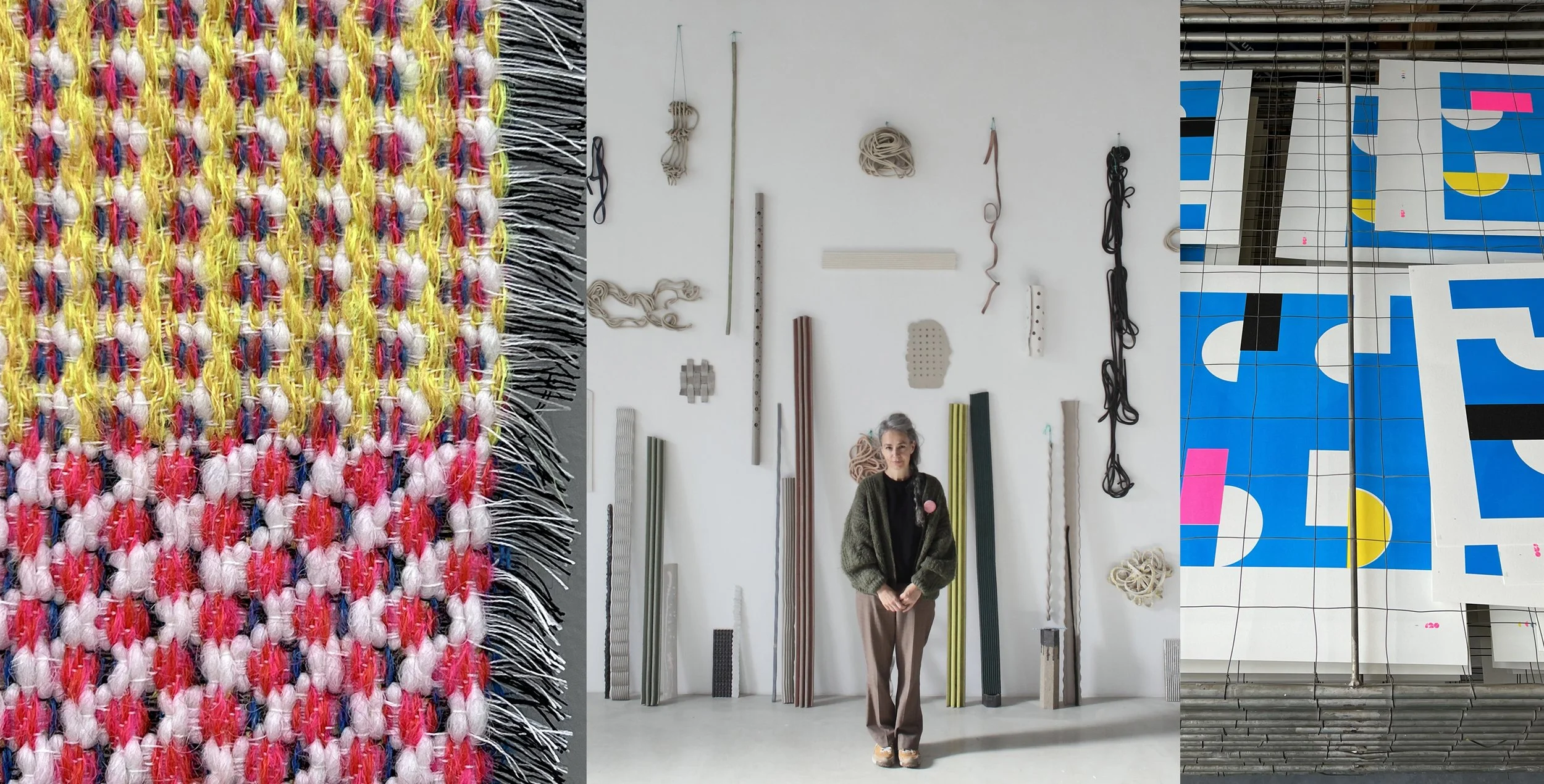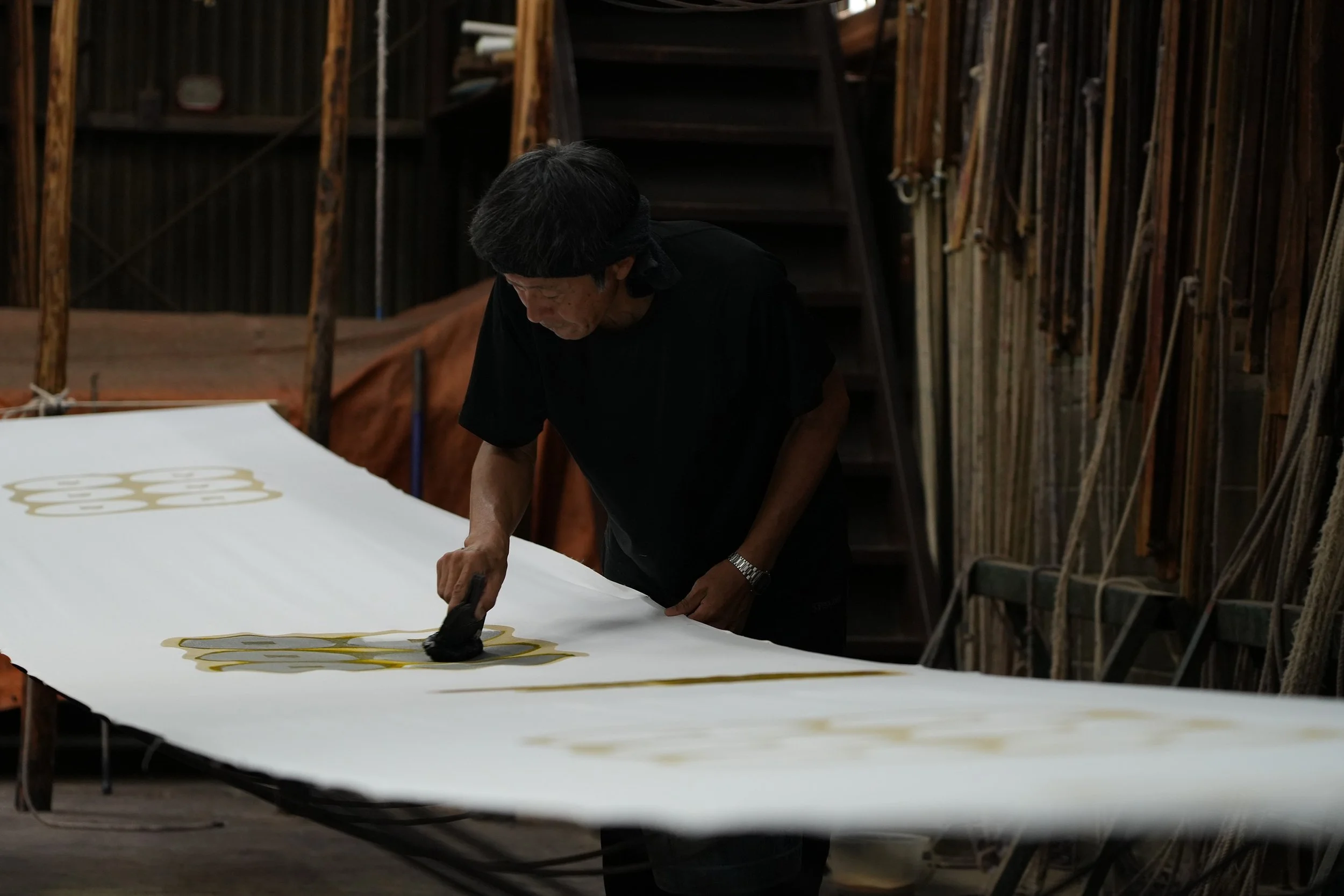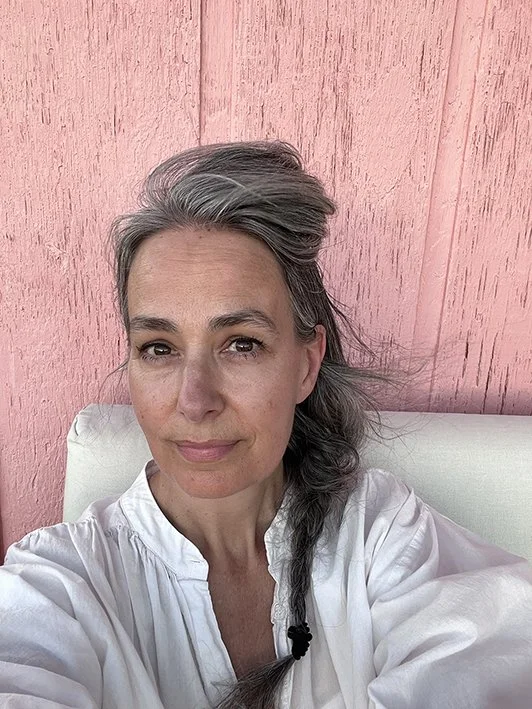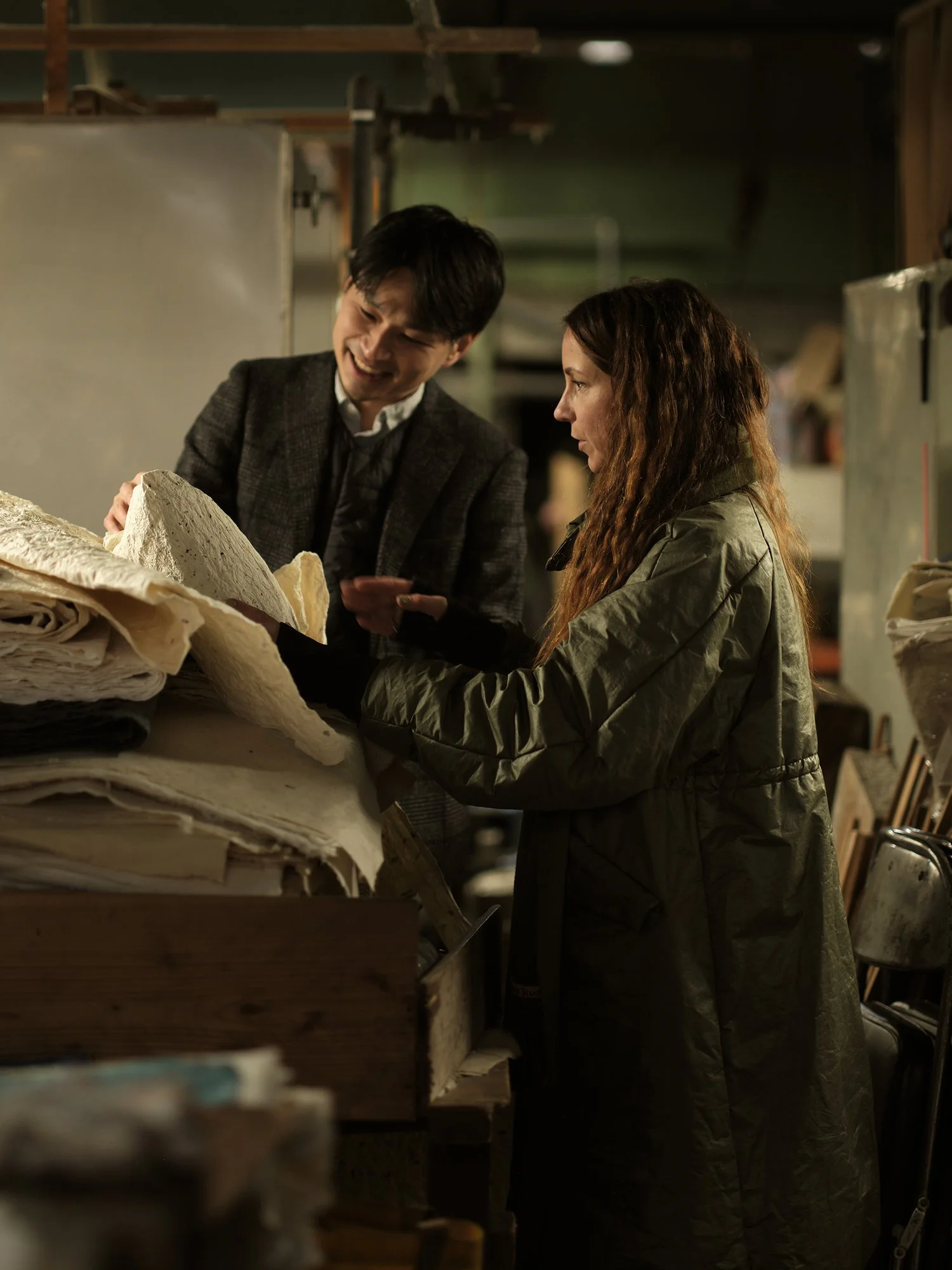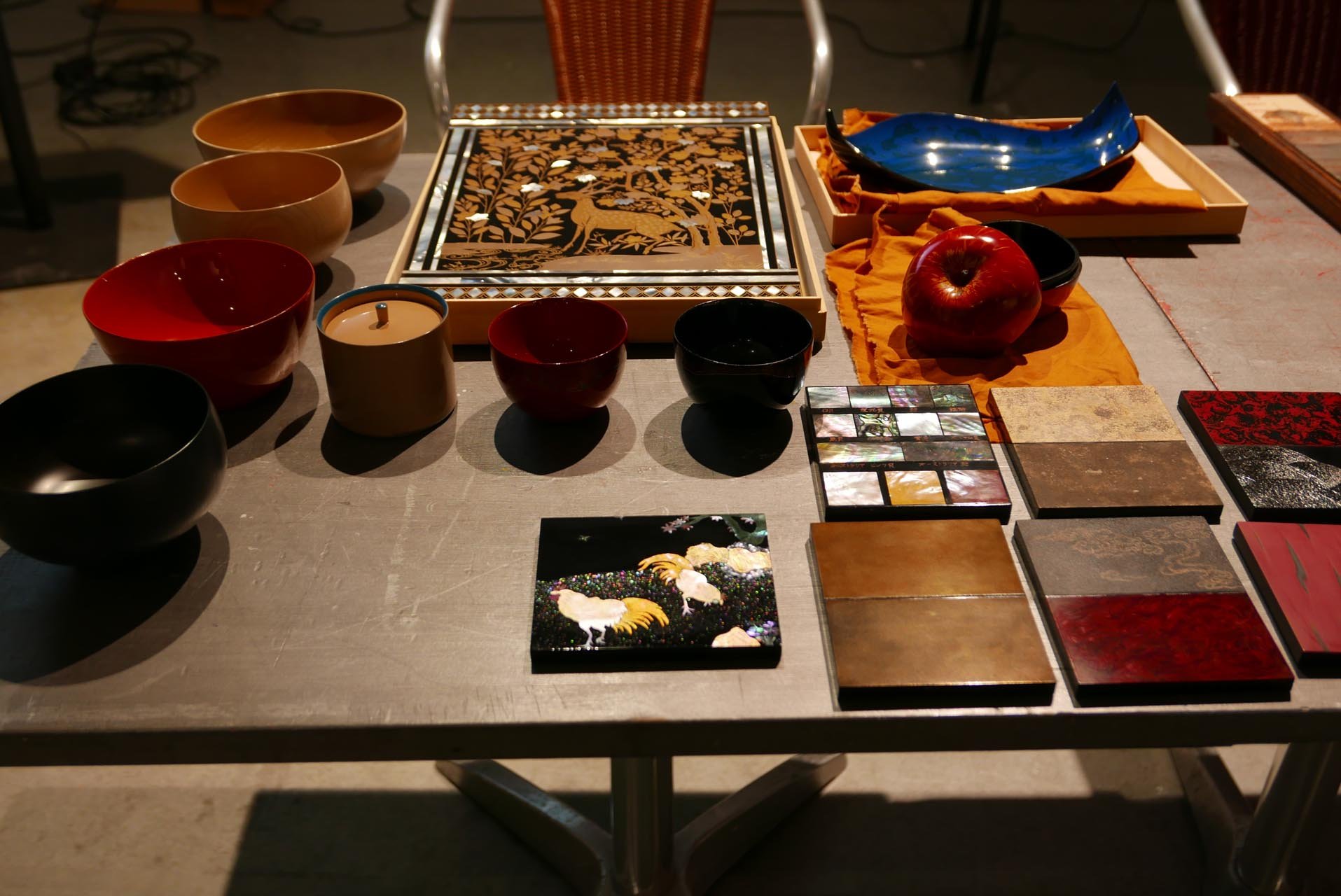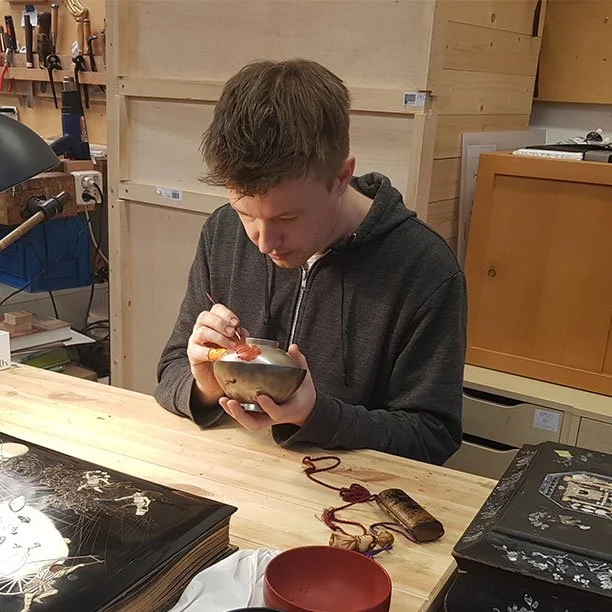Lectures
For our cultural programme, we have invited wonderful guests with diverse knowledge and backgrounds. Daily lectures will be given by artisans and designers engaged in exciting international collaborations between Japan and the Netherlands, as well as by initiators of cultural projects.
An entrance ticket is required to attend the lectures. No pre-booking is required.
Location: Nieuwe Instituut
Schedule
September 13th
-
Time: 12:00 - 13:30
By Sigrid Calon x Shohei Kubo (KANMAKI) and Laura Luchtman (Studio Kukka) x Tsuyoshi Kato (kiten.kyoto)
September 14th
-
Time: 13:00-14:00
By Yohei Oue (Oue co.) and the Dutch designer Mae Engelgeer
-
Time: 15:00-16:00
By Dave van Gompel
September 15th
-
Time: 11:30-12:30
By Jikke van Loon (Artist and Initiator of the Nio-Mon Project)
-
Time: 13:00-14:00
By Thomas Uljee & Bert Mulder (TOMASU SOY SAUCE) and Marika Groen (Malica Ferments)
-
Time: 15:00-16:00
By Shinya Kobayashi (MUJUN), Emiko Chujo (MONO JAPAN), and selected artist for AIR program
Lecture 01.
Creative Synergies in the MONO MAKERS PROGRAM: A Mid-Project Report
Presentation
Date and time: September 13th (Fri) 12:00-13:30
The MONO MAKERS PROGRAM (MMP) is a Dutch-Japanese creative collaboration initiative run by MONO JAPAN in partnership with NN Life Japan. Launched in 2023, this program facilitates the meeting and collaboration between Japanese manufacturing professionals and Dutch designers through MONO JAPAN's online platform, MONO MAKERS MEET (MMM).
Last year, the collaboration between Mae Engelgeer and Yohei Oue successfully led to the development of a new product, and they have continued their partnership. In the program's second year, globally acclaimed artist Sigrid Calon and Shohei Kubo of KANMAKI, a Kyoto-based company known for its innovative approach to gold leaf and pigment foil, were selected as the First Prize winners and are collaborating with hands-on support.
KANMAKI is traditionally known for its gold leaf, but it also produces foils in various colours used in diverse applications, including automotive parts. KANMAKI is exploring new uses for its foils, focusing on creating consumer products and environmentally conscious manufacturing. Through her collaboration with Kubo, Calon has been experimenting extensively with the samples provided by KANMAKI, discovering new possibilities and unique qualities of the materials.
Laura Luchtman (Studio Kukka) and Tsuyoshi Kato (kiten.kyoto) have been awarded the Special Jury Prize and are working on their collaboration independently without hands-on support. Their collaboration was highly praised by the judging panel for its potential to develop actual products, and the two have begun working together on prototypes.
Join us for a mid-project report, where we will explore the potential outcomes and innovative synergy between the creative pairs Sigrid Calon and Shohei Kubo, and Laura Luchtman and Tsuyoshi Kato, as they approach the completion of their collaboration in March 2025. We will be joined by the collaborators themselves, along with Hoya from NN Life Japan, the supporter of the MONO MAKERS PROGRAM, who will share insights and progress from these exciting partnerships.
Speakers
Sigrid Calon
Dutch artist Sigrid Calon builds her language out of pure and geometric patterns, interlacing graphics on every media, in any possible combination. After an academic education and a design debut, she established herself as a visual artist; her work is a continuous compositive exploration, conceptually complex, but always aesthetically minimal, and often ironic.
Shohei Kubo
Born in Ohara, Kyoto in 1980. From 1998 to 2005, he was involved in over 120 stage plays as a scriptwriter and director. After starting his own business with support from Kyoto City in 2006, he joined his family business, Kansai Makitori Haku Kogyo Co., Ltd., in 2012 and became the CEO of this company.
He has won a number of prizes for his innovative entrepreneurship a participated in collaborative projects with overseas designers and creators, including “Inspiration of KYOTO (2022)” and MONO MAKERS PROGRAM (2024).
Laura Luchtman
Laura Luchtman, the textile and surface designer at atelier Kukka, is known for her innovative and colourful designs. She bridges craft and industrial production, creating contemporary designs based on tradition. Having explored Japan and delved into its culture, she has developed a profound admiration for its aesthetics and customs.
Tsuyoshi Kato (kiten.kyoto)
KatouKen Flag Shop, established in 1950, specialises in producing flags, 'noren' (traditional Japanese shop curtains), and similar items, believing that their products become symbols for their customers, carrying both history and hopes for the future. Committed to preserving and nurturing this cultural heritage, the company launched the lifestyle brand kiten.kyoto in October 2023 under the direction of Tsuyoshi Kato, who studied product development and branding at an artisanal studio in Kyoto. Backed by KatouKen Flag Shop's traditional craftsmanship and commitment to stand by those who wish not to compromise, kiten.kyoto proudly continues the KatouKen legacy, offering products that provide a little more convenience with an extra touch of excitement.
Yumiko Hoya
CSV Initiatives Team/Family Business Innovation Lab committee at NN Life Insurance Company, Ltd.
Lecture 02.
From Collaboration to Innovation: The Journey of Mae Engelgeer and Yohei Oue in the MONO MAKERS PROGRAM
Talk
Date and time: September 14th (Sat) 13:00-14:00
The MONO MAKERS PROGRAM (MMP) is a Dutch-Japanese creative collaboration initiative managed by MONO JAPAN in partnership with NN Life Japan. Through MONO JAPAN's online platform, MONO MAKERS MEET (MMM), Japanese manufacturing professionals and Dutch designers come together to form innovative collaborative pairs.
In its first year, 2023, the program featured the collaboration between Mae Engelgeer, a Dutch textile designer renowned globally, and Yohei Oue of Oue Co., Ltd. During the MONO JAPAN Fair last year, the duo presented their progress, which led to the successful development of new products. In March 2024, they unveiled their prototypes at an event in Kyoto. Following this success, Yohei Oue launched the brand Yorai Washi, with Mae continuing as a partner to introduce various interior items.
Mae, who has recently established an office in Kyoto to expand her activities in Japan, will join us online, and we will be accompanied by Yohei Oue, who is exhibiting at the MONO JAPAN Fair as Yorai Washi. They will share their experiences with the MONO MAKERS PROGRAM, the current state of their collaboration, and their vision for the future.
Join us for an insightful discussion on the transformative journey of Mae Engelgeer and Yohei Oue through the MONO MAKERS PROGRAM and the exciting prospects that lie ahead.
Speakers
Yohei Oue
After graduating from university, Yohei Oue worked for five years in sales of printed materials and corporate sales promotion at a major printing and advertising company in Japan. Following this, he spent two years in New Delhi with an Indian consulting firm, supporting Asian companies investing in India as a sales representative. Now, at Oue Paper, he applies his expertise to explore new possibilities for Japanese washi paper.
Mae Engelgeer
Textile design has always been at the heart of Dutch designer Mae Engelgeer's work, beginning with her early days in high school and continuing through her studies at the Amsterdam Fashion Institute and Sandberg Instituut. Since founding her own studio in 2013, she has nurtured her curiosity for the craft, exploring within the established boundaries of textile production while pushing traditional techniques into contemporary realms.
Mae's creations embrace subtle colour palettes, patterns and linear elements. She combines complex compositions with perfection to achieve harmony and explores innovative contrasts in materials and textures, crafting works known for their luxurious tactility and dimensional quality.
Beyond her own collections, Mae collaborates globally with brands on a wide range of projects, from textile products, furniture design, material explorations and art direction to large-scale installations and public artworks.
Urushi: an introduction
Demonstration of Urushi Lacquer craft
Date and time: September 14th (Sat) 15:00-16:00
Lecture 03.
Japanese lacquer, known as urushi, is a fascinating yet lesser-known material that has been used to decorate items for thousands of years. Training in urushi takes many years due to its highly labour-intensive process and the use of precious materials such as mother of pearl and pure gold.
This lecture will delve into the fundamental properties of urushi, featuring demonstrations of gold sprinkling techniques. It will also briefly explore the aesthetics and philosophies behind lacquer art. Some may already be familiar with these concepts through the increasingly popular practice of kintsugi, which uses urushi to mend fractures in ceramics and enhances them with gold sprinklings.
speaker
Dave van Gompel
Dave van Gompel is an art historian and restorer. Following his time at the Rijksmuseum, he spent five years in Japan studying traditional lacquer art, particularly maki-e or paintings in sprinkled gold. Upon graduating from Tokyo University of the Arts, he returned to Amsterdam to establish his business as a lacquer restorer.
Dave also contributes to the field through publications on lacquer art and is involved in producing a new generation of lacquerware that promotes collaboration between Western designers and Japanese craftspeople.
Lecture 04.
Project Nio-Mon, Building A Portal, A Home
Lecture
Date and time: September 15th (Sun) 11:30-12:30
In this lecture, Artist Jikke van Loon invites participants on an exciting journey to the hometown of two magnificent Japanese temple guardians, now housed in the Rijksmuseum of Amsterdam.
These guardians originated from Yokota, a town in the remote prefecture of Shimane, where once a year, all thousand gods of Japan convene.
After a prolonged absence, the guardians reappeared in the village in 2018, adorned in Delft blue tiled suits! This recreation was part of a collaborative project called Issho-ni/Tomo-ni, involving hundreds of people from both the Netherlands and Japan.
Currently, plans are underway for their return to their former residence, the Niōmon gate at the Iwayaji temple area. However, the gate is in dire need of restoration, and a collaboration project is being explored with two local temple craftspeople and the College of Architecture in Kyoto to address this.
The journey alongside these temple guardians holds as much significance as the destination itself.
*Niōmon is a gate at the entrance to a Japanese temple area, housing two Japanese temple guards (NIO): the Agyou and UNgyou. The sounds 'A' and 'UN' they make are the first and last syllables of the Siddham script, and together, they represent all possible sounds, thus symbolising all knowledge, wisdom and compassion. Whoever walks through the gate and passes these guards gets access to this wisdom. In this art project, this 'wisdom' refers to the wisdom, knowledge and compassion found in connecting with each other and immersing ourselves in each other's worlds.
For more information, see: www.nio-mon.com
Speaker
Portret photo: Kiriko Mechanicus
Jikke van Loon
Jikke van Loon (The Hague, 1971) is a visual artist based in Amsterdam. Her work is renowned for its high degree of physicality and close observation, intertwined with a rich imagination. This interplay creates a field of tension between the large and spatial, and the small and detailed. Jikke creates works for public spaces, exhibitions and reports on Staggering Encounters.
Black, Stones and Life of Objects are entities and concepts that play a significant role in Jikke's work. With a curious mind and eyes on stems, she tries to emancipate both Things and herself, fostering a sense of confidence in this vast world. Her art conveys questions rather than answers, a concept that shines through in her drawings, performative acts, happenings, and sculptures.
Some of Jikke's works in public spaces include Anton de Kom (the monument for Anton de Kom, Amsterdam), Koning met Baard (Den Haag), Maduro (Den Haag), Niet geheten, niet geweten (Hoorn), Issho-ni Tomo-ni (re-creating pure wisdom, Together!, Yokota, Japan).
Lecture 05.
Talk: Thomas Uljee & Bert Mulder (TOMASU SOY SAUCE) x Marika Groen Kawaguchi (Malica Ferments)
Date and time: September 15th (Sun) 13:00 - 14:00
Tomasu Soy Sauce, based in Rotterdam, is a Dutch soy sauce producer owned by four individuals. Tomasu’s soy sauce brand has not only gained popularity in the Netherlands but has also achieved international acclaim. As a staple seasoning in Japanese cuisine, soy sauce plays a vital role for people in Japan and is a must-have in every Japanese household. Given its significance in Japanese culture, this prompts some intriguing questions: how did these Dutch individuals come to produce soy sauce, and how did they create such a widely-loved product despite it not being part of their local culinary tradition?
In this inaugural project, we welcome Marika Kawaguchi, a Japanese ‘fermentation queen’ based in the Netherlands and close friend of MONO JAPAN and Tomasu Soy Sauce, as an interviewer to uncover the lesser-known mysteries behind Tomasu Soy Sauce.
Speaker
Tomasu Soy Sauce
Tomasu Soy Sauce began with a simple question: "Can we brew soy sauce?" This curiosity has evolved into a vertically integrated food chain, allowing them to dig deep and start to understand their craft. From soil to bottle, Tomasu Soy Sauce produces soy sauce in their own unique way. Understanding that flavour demands time, they have never compromised on quality. No shortcuts, no tricksーjust common sense, a serious dose of DIY, guided by nature, and an unwavering commitment to excellence. Tomasu Soy Sauce is still at the beginning of their journey, with more questions than answers yet to explore.
Portret photo: Shinji Otani
Marika Groen Kawaguchi
Marika is a Kojiologist, travelling brewer, photographer, writer, and the driving force behind Malica Ferments. Originally from Japan and now based in Europe, Marika focuses on research and development of fermentation. She hosts the occasional 3-4 day "Kojiology" retreat, where participants learn about koji, miso, shoyu, doburoku sake, and natto, and leads an annual fermentation tour that includes brewery visits. In 2021, she published the artistic manual Cosy Koji as a visual collaboration with her fellow fermenters. The year 2024 holds new mysteries for Marika.
Lecture 06.
Introducing AKIYA AIR: A New Dutch-Japanese Artist-in-Residence Program
Presentation
Date and time: September 15th (Sun) 15:00 - 16:00
AKIYA AIR is a new artist-in-residence program launching this year by Stichting MONO JAPAN and MUJUN, an organisation that has been acquiring mountains and vacant houses (Akiya) in Yunotsu, Shimane Prefecture. Initially introduced as a concept at last year's MONO JAPAN, the program is now set to commence.
This presentation will explore the activities and objectives of the Dutch participants who will begin their residency in Yunotsu this October as part of AKIYA AIR. Leading the discussion will be Shinya Kobayashi from MUJUN and Emiko Chujo from Stichting MONO JAPAN.
Speakers
Shinya Kobayashi
Director of the MUJUN
Shinya Kobayashi, born in 1987 in Ono City, Hyogo Prefecture, graduated from Osaka University of Arts in 2010 with a degree in Product Design. He then opened a shop called Tokitsukaze in Yunotsu Onsen, Shimane Prefecture, a UNESCO World Heritage Site. Tokitsukaze is centred around the concept of Satoyama and combines a gallery, product sales, cafes, snacks, and a sauna.
In 2011, Shinya founded Coelacanth Shokudo, a company focused on innovation design. The company launched its original product brand, “MUJUN”, in Amsterdam in 2016. This was followed by the establishment of the MUJUN Workshop in July 2018, a new and sustainable system for finding and nurturing successors for local cutlery craftspeople.
In April 2020, MUJUN founded MUJUN Planet, a village in Yunotsu designed to cultivate the image of true craftspeople and increase the self-sufficiency rate of manufacturing. MUJUN Planet serves as a place where anyone can become a craftsperson. In December 2021, Kobayashi’s team established Satoyama Installation LLC in Yunotsu.
Emiko Chujo
Director of MONO JAPAN (Japan Cultural Exchange and Stichting MONO JAPAN)
Emiko Chujo moved to Amsterdam in 2000 after working as a designer for an advertising agency in Japan. She continued her career in advertising and travel, organising various cultural events and managing planning and PR in multiple capacities.
In February 2015, Emiko established the Japan Cultural Exchange as a sole proprietorship. With a focus on curating Japanese craftsmanship for a European audience and adequately conveying the background of Japanese manufacturing, she hosted MONO JAPAN the following year. Since 2019, Emiko has successfully managed Japan-Netherlands creative collaboration projects, leading to the establishment of MONO JAPAN Foundation in the Netherlands in November 2019 to ensure continuous operation. Emiko, along with four other board members, continues to focus on cultural projects.


